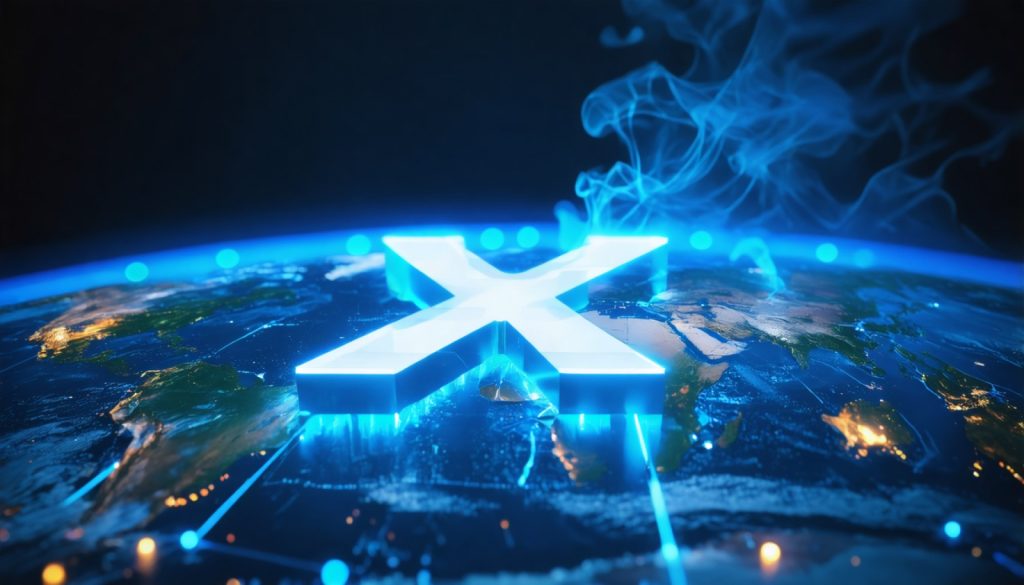
- XRP is believed to have a hidden valuation far beyond its current market price, according to Versan Aljarrah, CEO of Black Swan Capitalist.
- Aljarrah suggests XRP’s value is determined through private negotiations among major financial institutions like JP Morgan, BlackRock, and the Bank for International Settlements (BIS).
- XRP is envisioned as a key player in international trade, potentially streamlining cross-border payments and supporting blockchain interoperability.
- Aljarrah forecasts a significant increase in XRP’s price to support global financial transactions but faces skepticism from critics who cite prevailing market conditions as a barrier.
- The discussion highlights XRP’s potential role as a transformative digital asset within the financial ecosystem, hinting at a future where its real value is shaped by institutional influences.
In the heart of the global financial theater, where institutions orchestrate movements that ripple through economies, a powerful narrative unfolds. XRP, a digital currency often under scrutiny, is whispered to possess a hidden valuation known only to the world’s financial giants. According to Versan Aljarrah, CEO of Black Swan Capitalist, the price we see today—nudged by retail traders—is but a shadow of its preordained potential.
This clandestine pricing mechanism mimics the rituals of Wall Street, where a company’s fate is sealed by hedge funds and banks long before the public gets a glimpse. Aljarrah posits that the value of XRP has been quietly cemented through backchannel negotiations among the titans—central banks, financial behemoths like JP Morgan and BlackRock, and the influential Bank for International Settlements (BIS).
Imagine XRP as a bridge arching over the tumultuous waters of international trade, poised to streamline cross-border payments and enhance blockchain interoperability. Aljarrah believes this digital asset has already found a foothold in the infrastructure of global banking, hinting at early adoption by countries spanning as diverse as Barbados to islands across the Caribbean.
His assessment suggests that for XRP to shoulder the enormity of global financial transactions, its price must be elevated significantly beyond what retail markets currently display. Retail price fluctuations, he stresses, are inconsequential when considering the institutional dialogues that determine XRP’s true worth. Aljarrah envisions a scenario where XRP’s integration into global systems will necessitate a valuation in the hundreds, if not thousands.
Yet, this theory meets skepticism. Critics ponder why any institution would consent to pay a premium for XRP when market rates remain grounded. Tank Sinatra, a well-known community voice, challenges this proposition, underscoring a fundamental economic principle: pay no more than the prevailing market dictates.
The intrigue here lies in the possibility that the value of XRP could ascend well beyond today’s market price, driven by its utility in underpinning vast, trillion-dollar financial networks. If Aljarrah’s projection holds true, XRP is not just a digital currency but a critical component of the financial ecosystem’s evolution—a signpost pointing towards a future where digital assets silently command transformative power behind the scenes.
As the story of XRP continues to unfold, it leaves a compelling takeaway: the real price of innovation often lies hidden beneath the surface, shaped by the invisible hands of those who mold the world’s financial destiny.
Is XRP Poised for a Hidden Valuation Surge? Unpacking the Myths and Realities
Understanding the Potential of XRP Beyond Market Speculation
XRP, a digital currency often embroiled in controversy and speculation, has captured the attention of financial experts and traders alike. A narrative recently posited by Versan Aljarrah, CEO of Black Swan Capitalist, suggests that XRP’s current market price is only a glimpse of its true, concealed value. This viewpoint is steeped in theories involving behind-the-scenes engagements with financial powerhouses such as central banks, JP Morgan, BlackRock, and the Bank for International Settlements (BIS).
Unveiling the Mystique of Institutional Pricing Mechanisms
Aljarrah likens XRP’s pricing mechanism to Wall Street’s modus operandi, where stock prices are often influenced by institutional actors long before public involvement. This theory suggests that XRP’s price is set privately among significant financial players, perhaps at values much higher than current market rates. This concept asserts that XRP’s utility—particularly in facilitating seamless cross-border payments and improving blockchain interoperability—warrants a substantial price increase.
Market Forecasts and Industry Trends
1. Institutional Adoption: As blockchain technology gains traction, XRP’s role as a bridge in global banking systems could expand. Institutions seeking efficient, low-cost alternatives for international transactions may propel XRP into wider adoption and higher valuations.
2. Regulatory Landscape: Regulatory clarity could be a double-edged sword for XRP. While supportive regulations may boost institutional adoption, stringent laws could impede growth. The ongoing SEC lawsuit against Ripple Labs is a significant factor influencing XRP’s future.
3. Technological Integration: The push towards central bank digital currencies (CBDCs) might integrate or compete with technologies like XRP. The interplay between centralized digital currencies and decentralized assets will be crucial in determining market dynamics.
Pros and Cons Overview
Pros:
– Utility: XRP facilitates rapid and inexpensive cross-border transactions.
– Scalability: It can handle 1,500 transactions per second, making it a robust option for financial systems needing high throughput.
– Energy Efficiency: Compared to Bitcoin, XRP consumes significantly less energy for validations, appealing to environmentally conscious enterprises.
Cons:
– Regulatory Challenges: The SEC lawsuit injects uncertainty into XRP’s market perception.
– Market Volatility: Like many cryptocurrencies, XRP’s price can be highly volatile.
– Lack of Decentralization: Critics argue that Ripple’s significant control over XRP challenges the tenets of blockchain decentralization.
Real-World Use Cases
Financial institutions looking for cost-effective cross-border transaction solutions may find XRP appealing. Its integration into banking systems can lower transaction fees and enhance transaction speed, potentially transforming global payment infrastructures.
Expert Insights and Predictions
Many experts believe that if XRP’s use case continues to expand within international trade, its value proposition will rise correspondingly. Financial analysts, however, urge caution, pointing out the current legal hurdles and the unpredictable nature of cryptocurrency markets.
Actionable Recommendations
1. Diversification: Investors should consider diversifying their portfolios to balance risks associated with individual digital currencies.
2. Stay Informed: Keeping abreast of legal developments and financial regulations affecting XRP is crucial for potential investors.
3. Engage in Research: Thoroughly research XRP’s technological benefits and challenges to make informed investment decisions.
For deeper insights into cryptocurrency markets and potential investment strategies, visit Nasdaq.
Conclusion
While the narrative of XRP’s hidden valuation remains a topic of debate, its impact on global finance is undeniable. Investors and market watchers must weigh potential benefits against risks as they navigate the evolving landscape of digital assets. Understanding these dynamics can provide a clearer picture in determining whether XRP will ascend to the valuation heights some predict.



